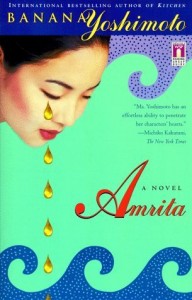Last night I finished Banana Yoshimoto's Amrita. I think that makes all of her major works, but I will have to compare my bookshelf against her bibliography sometime to be sure. As is often the case, her writing is a little bit dark and otherworldly. It's about a girl whose father dies, whose sister becomes a movie star and kills herself, who falls and hits her head and loses her memory, and whose brother suddenly starts to see ghosts. And I guess it's about love and families, too, and… scents.
I wish I read Japanese, because the style of the book (and most of her work) in translation is startlingly simple. Sentences are short and make direct statements. A third grader could read most of her work, the way it has been translated into English, and I wonder if it is the same in Japanese.
She gives an afterward at the end in which she apologizes for the naivete of her writing, and wonders if she will ever write a book so long again. It's a nice contrast to, say, the forewords in early Nabakov novels, where he asserts that he is a genius and takes the time to explain the references and parallels you will miss when you read the book. And at that, there is some kind of similarity between the two styles that I'm having trouble putting my finger on… between Bend Sinister or Invitation to a Beheading and Yoshimoto's writing.
Maybe I'm crazy.

